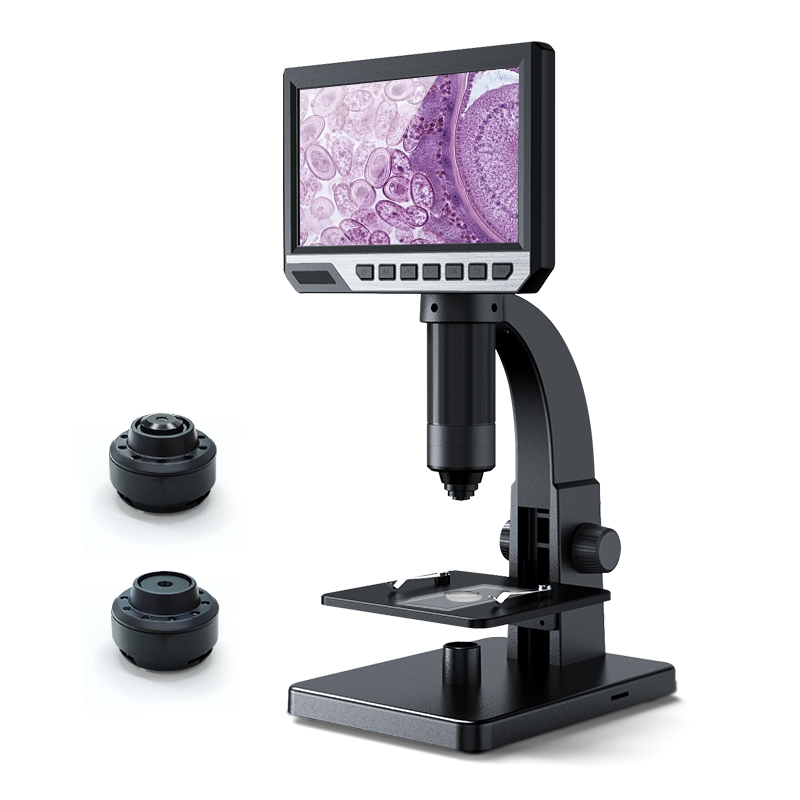An LCD microscope, or liquid crystal display microscope, finds extensive applications in civilian fields. Here are some of the main areas:
 - **Educational field**: It is suitable for children and students to explore science, helping them observe the microscopic world such as plant cells and insect wing structures, and stimulating their interest in science. It can also be used in classroom teaching. Teachers can project microscopic images onto a large screen through an LCD microscope, making it convenient for the whole class to observe at the same time and improving teaching effectiveness.
- **Collection field**: It is a powerful tool for collectors of coins, stamps, antiques, etc. It can be used to observe the casting details, wear degree, and anti-counterfeiting marks of coins, as well as the perforations, pattern details, and watermarks of stamps, helping to identify authenticity and evaluate value. In addition, it can be used to observe the glaze cracks of antique porcelain, the brushstrokes of calligraphy and painting, and the texture of paper, assisting in identifying the age and authenticity of antiques.
- **Electronic maintenance field**: It can be used to check whether the solder joints on the circuit board are firm, whether there is a short circuit, and whether the component pins are loose, helping maintenance personnel accurately find fault points and improve maintenance efficiency and accuracy.
- **Jewelry identification field**: It can observe the internal structure, flaws, and texture of jewelry and jade, such as the internal inclusions of diamonds and the crystal structure of jadeite, assisting in identifying the quality and authenticity of jewelry. It can also be used to check whether the inlay of jewelry is firm and whether the metal bracket is damaged.
- **Textile and clothing field**: It can be used to observe the fiber structure, weaving method, and fabric flaws of textiles, helping consumers or professionals understand the quality and characteristics of fabrics. In addition, in the process of clothing design and research and development, it can also be used to study the microscopic structure of new fabrics, providing references for design and innovation.
- **Beauty and skin care field**: It can be used to observe skin texture, pore size, and tiny flaws on the skin surface, helping beauticians or individuals understand skin conditions and thus formulate more appropriate skin care plans. It can also be used to observe hair quality and hair follicle conditions, providing a basis for hair care.
- **Insect and biological observation field**: It is convenient for observing the morphological structure, wing texture, and antenna details of insects, and can also be used to observe small organisms such as parasites and microorganisms, meeting the observation needs of biology enthusiasts.
- **Educational field**: It is suitable for children and students to explore science, helping them observe the microscopic world such as plant cells and insect wing structures, and stimulating their interest in science. It can also be used in classroom teaching. Teachers can project microscopic images onto a large screen through an LCD microscope, making it convenient for the whole class to observe at the same time and improving teaching effectiveness.
- **Collection field**: It is a powerful tool for collectors of coins, stamps, antiques, etc. It can be used to observe the casting details, wear degree, and anti-counterfeiting marks of coins, as well as the perforations, pattern details, and watermarks of stamps, helping to identify authenticity and evaluate value. In addition, it can be used to observe the glaze cracks of antique porcelain, the brushstrokes of calligraphy and painting, and the texture of paper, assisting in identifying the age and authenticity of antiques.
- **Electronic maintenance field**: It can be used to check whether the solder joints on the circuit board are firm, whether there is a short circuit, and whether the component pins are loose, helping maintenance personnel accurately find fault points and improve maintenance efficiency and accuracy.
- **Jewelry identification field**: It can observe the internal structure, flaws, and texture of jewelry and jade, such as the internal inclusions of diamonds and the crystal structure of jadeite, assisting in identifying the quality and authenticity of jewelry. It can also be used to check whether the inlay of jewelry is firm and whether the metal bracket is damaged.
- **Textile and clothing field**: It can be used to observe the fiber structure, weaving method, and fabric flaws of textiles, helping consumers or professionals understand the quality and characteristics of fabrics. In addition, in the process of clothing design and research and development, it can also be used to study the microscopic structure of new fabrics, providing references for design and innovation.
- **Beauty and skin care field**: It can be used to observe skin texture, pore size, and tiny flaws on the skin surface, helping beauticians or individuals understand skin conditions and thus formulate more appropriate skin care plans. It can also be used to observe hair quality and hair follicle conditions, providing a basis for hair care.
- **Insect and biological observation field**: It is convenient for observing the morphological structure, wing texture, and antenna details of insects, and can also be used to observe small organisms such as parasites and microorganisms, meeting the observation needs of biology enthusiasts.



 You are here :
You are here :
 - **Educational field**: It is suitable for children and students to explore science, helping them observe the microscopic world such as plant cells and insect wing structures, and stimulating their interest in science. It can also be used in classroom teaching. Teachers can project microscopic images onto a large screen through an LCD microscope, making it convenient for the whole class to observe at the same time and improving teaching effectiveness.
- **Collection field**: It is a powerful tool for collectors of coins, stamps, antiques, etc. It can be used to observe the casting details, wear degree, and anti-counterfeiting marks of coins, as well as the perforations, pattern details, and watermarks of stamps, helping to identify authenticity and evaluate value. In addition, it can be used to observe the glaze cracks of antique porcelain, the brushstrokes of calligraphy and painting, and the texture of paper, assisting in identifying the age and authenticity of antiques.
- **Electronic maintenance field**: It can be used to check whether the solder joints on the circuit board are firm, whether there is a short circuit, and whether the component pins are loose, helping maintenance personnel accurately find fault points and improve maintenance efficiency and accuracy.
- **Jewelry identification field**: It can observe the internal structure, flaws, and texture of jewelry and jade, such as the internal inclusions of diamonds and the crystal structure of jadeite, assisting in identifying the quality and authenticity of jewelry. It can also be used to check whether the inlay of jewelry is firm and whether the metal bracket is damaged.
- **Textile and clothing field**: It can be used to observe the fiber structure, weaving method, and fabric flaws of textiles, helping consumers or professionals understand the quality and characteristics of fabrics. In addition, in the process of clothing design and research and development, it can also be used to study the microscopic structure of new fabrics, providing references for design and innovation.
- **Beauty and skin care field**: It can be used to observe skin texture, pore size, and tiny flaws on the skin surface, helping beauticians or individuals understand skin conditions and thus formulate more appropriate skin care plans. It can also be used to observe hair quality and hair follicle conditions, providing a basis for hair care.
- **Insect and biological observation field**: It is convenient for observing the morphological structure, wing texture, and antenna details of insects, and can also be used to observe small organisms such as parasites and microorganisms, meeting the observation needs of biology enthusiasts.
- **Educational field**: It is suitable for children and students to explore science, helping them observe the microscopic world such as plant cells and insect wing structures, and stimulating their interest in science. It can also be used in classroom teaching. Teachers can project microscopic images onto a large screen through an LCD microscope, making it convenient for the whole class to observe at the same time and improving teaching effectiveness.
- **Collection field**: It is a powerful tool for collectors of coins, stamps, antiques, etc. It can be used to observe the casting details, wear degree, and anti-counterfeiting marks of coins, as well as the perforations, pattern details, and watermarks of stamps, helping to identify authenticity and evaluate value. In addition, it can be used to observe the glaze cracks of antique porcelain, the brushstrokes of calligraphy and painting, and the texture of paper, assisting in identifying the age and authenticity of antiques.
- **Electronic maintenance field**: It can be used to check whether the solder joints on the circuit board are firm, whether there is a short circuit, and whether the component pins are loose, helping maintenance personnel accurately find fault points and improve maintenance efficiency and accuracy.
- **Jewelry identification field**: It can observe the internal structure, flaws, and texture of jewelry and jade, such as the internal inclusions of diamonds and the crystal structure of jadeite, assisting in identifying the quality and authenticity of jewelry. It can also be used to check whether the inlay of jewelry is firm and whether the metal bracket is damaged.
- **Textile and clothing field**: It can be used to observe the fiber structure, weaving method, and fabric flaws of textiles, helping consumers or professionals understand the quality and characteristics of fabrics. In addition, in the process of clothing design and research and development, it can also be used to study the microscopic structure of new fabrics, providing references for design and innovation.
- **Beauty and skin care field**: It can be used to observe skin texture, pore size, and tiny flaws on the skin surface, helping beauticians or individuals understand skin conditions and thus formulate more appropriate skin care plans. It can also be used to observe hair quality and hair follicle conditions, providing a basis for hair care.
- **Insect and biological observation field**: It is convenient for observing the morphological structure, wing texture, and antenna details of insects, and can also be used to observe small organisms such as parasites and microorganisms, meeting the observation needs of biology enthusiasts. Website
Website
